
Discover
ISSUE #1 SPRING 2024 NEW SEASON, NEW LIFE Member of Edible Communities
edible sea to sky Taste the Goodness,
the Roots
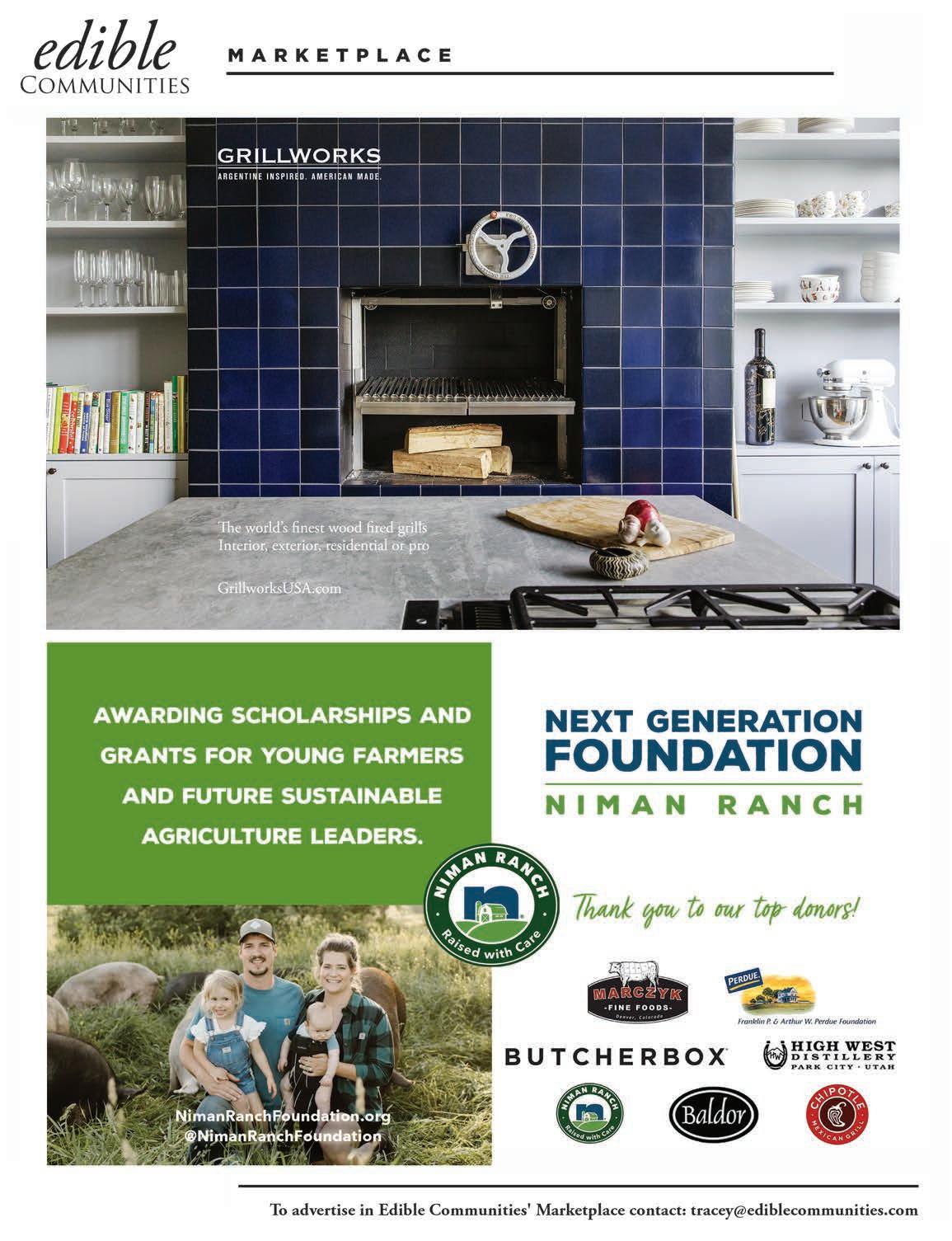
RECIPE: Rosemary Rye Crackers with Apricots and Walnuts
FEATURE: The Art of Farming
Borrowing Biodiversity

RECIPE: Gravlax Salmon Pesto Salad Stalking
RECIPE: Sea to Sky 75
Edible SEA TO SKY acknowledges that we work, play, eat and grow on the unceded territories of the Sḵwx̱wú7mesh Úxwumixw (Squamish Nation), the St'át'imc Nation and the Líl'wat Nation. We are grateful for their stewardship of the land on which the culinary practices we celebrate take place.
Contents Letter from the Publisher Letter from the Editor
Eaters
Contributors Dirty Thoughts Growing Good
What Is a CSA?
Spring ' s Sweetness
WHAT ' S IN SEASON: Spring 2 3 4 6 10 12 14 22 26 28 30 31 32 THIS PAGE Spring Rhubarb Photo: Brenda Bakker COVER Howe Sound Picnic Photo: Vairdy Frail Food Styling: Christine Montgomery

Edible Sea to Sky Spring 2024
PUBLISHER
Terra Gaddes
EDITOR
Naomi Tomky
ART DIRECTOR
Vairdy Frail
COPY EDITOR
Susan Fitzgerald
DESIGNER
Bruce Cole
WEB DESIGN
Mary Ogle
SOCIAL MEDIA / NEWSLETTER
Morgan Smith
CONTACT
hello@edibleseatosky.com
SUBSCRIBE
Subscriptions are $32 for four issues and can be purchased online at edibleseatosky.com
Edible Sea to Sky is published quarterly and distributed throughout the region from Lions Bay to Lillooet.
Every effort is made to avoid errors, misspellings, and omissions. If, however, an error comes to your attention, please accept our sincere apologies and notify us. Thank you.
No part of this publication may be used without written permission of the publisher.
© 2024. All rights reserved.
Member of Edible Communities
LETTER FROM THE PUBLISHER

I’m thrilled you are here with me! It’s hard to put into words the excitement I feel as we publish the inaugural issue of Edible Sea to Sky
Back in March 2023, during a visit to Kingston, Ontario, I stumbled upon Edible Ottawa at our favourite bakery in town. Wide awake with jet lag at 11:00 p.m., I eagerly delved into it, seeking insider tips on Kingston’s food scene, hoping to discover new eateries and culinary delights. As I flipped through its pages, it struck me: “This is Edible Ottawa; I’ve seen Edible Vancouver and Wine Country; I’ve picked up Edible Seattle. There are more of these?” And so my journey began. Within three months, I found myself the publisher of a never-before-printed Edible Sea to Sky.
I’ve never worked in publishing before; for the past 27 years, I’ve been a child and youth care counsellor. How do I connect these seemingly disparate paths? I recall my first mentor at the group home where I worked saying “Share a meal with the kids. Food connects people and brings them together.” Those words resonated deeply with me. Indeed, food has an incredible power to unite us all. Over the past two decades, I’ve immersed myself in my community, witnessing its food culture evolve, sharing countless meals and connecting with remarkable individuals. With this magazine, my aim is to invite our readers to explore the vibrant community behind our food, discover new places, support local endeavours and foster connections over shared meals.
I am so thankful to the amazing team that has joined me on this journey, patiently guiding me through unfamiliar territory, and to our contributors who have breathed life into our first stories and left us eager for what lies ahead. Your creativity inspires me. And of course, none of this would be possible without the advertisers who have partnered with us in this inaugural issue, expressing their commitment to growing alongside us and supporting our mission of sharing our region’s stories.
I feel incredibly fortunate to have stumbled upon Edible Communities, though I can’t help but feel it was more than just luck. Time and again, I’ve been shown that this is exactly where I’m meant to be.
I can’t wait to take you all on this adventure with me.
Warm regards,
Terra Gaddes
2 | EDIBLE SEA TO SKY | SPRING 2024
edible sea
sky Taste the Goodness, Discover the Roots ISSUE #1 SPRING 2024 NEW SEASON, NEW LIFE Member of Edible Communities
to
LETTER FROM THE EDITOR

Happy spring, readers!
Even as an editor, I struggle to resist the enticing charms of spring’s clichés: the season of rebirth, baby animals born in newly green pastures and, in the Sea to Sky region, the re-emergence of life from beneath winter blankets of snow. This year, along with the first stalks of rhubarb and mewling lambs, the season brings forth the first issue of Edible Sea to Sky
As feels only appropriate, the debut issue celebrates new growth. From a profile of a Squamish business demonstrating how gardening can ease mental health struggles, to the aims of the Lillooet organization preserving plant diversity through seed saving and sharing, the stories collected here show off the many ways people in the Sea to Sky region grow what is necessary to nourish body, soil and soul.
Edible Sea to Sky is part of Edible Communities, a group of more than 90 independently owned magazines across North America, each focused on the hyper-local foodways of its own community. Our mission is to highlight the incredible farmers, ranchers, chefs, restaurants, culinary artisans and shops that make the Sea to Sky corridor such a delicious place to live — and to help you, our readers, find new ways to appreciate the bounty they produce.
This month, that comes in the form of pink ribbons of rhubarb gracing the Sea to Sky 75, a local twist on a classic cocktail. Heady, hearty rosemary enhances rye crackers perfect for scooping up whipped feta, and both star in the picnic menu featured on our very first cover. Plus, we have gathered expert gardening tips to help you nurture a little something of your own.
I invite you to pour yourself a glass of something sparkly — and local, of course — and toast with me: to spring, to the growth poking up from thawing ground and to the flowering of a new magazine. I hope that you enjoy reading about gardens that feed picky eaters and painting a farm that feeds two friends (and a town), and that you choose to support our fledgling publication by sharing it and subscribing to it. In return, I promise never to lean so hard on clichés in my editor’s letter again.
Thank you,
Naomi Tomky


Culinary Artistry Meets
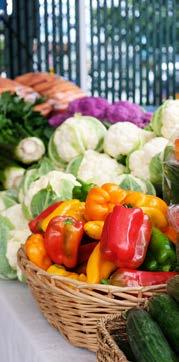
Saturdays between April 6 and December 14

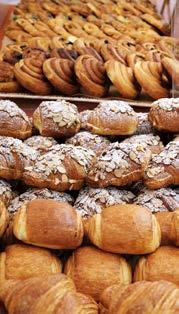
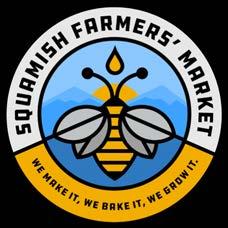

edibleseatosky.com | 3
In the �� of Downtown Squamish 37996 Cleveland Ave @squamishfarmersmarket
Impeccable Style
figfoodstyling.ca christine@figfoodstyling.ca @figfoodstyling
Christine Montgomery - Stylist & Pastry Chef
CONTRIBUTORS
We asked our contributors for our inaugural issue, What are your favourite first signs of spring?









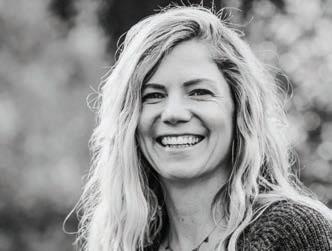


4 | EDIBLE SEA TO SKY | SPRING 2024
Ashley Drody Photographer
“I love seeing the first snowdrops popping up in February.”
Brenda Bakker Photographer “The waterways flowing differently, signs of the bears waking and seeing the mamas helping the little ones find their way.”
Kerry McCann Writer “Icicles lengthening, birds returning, the colour of buds starting to swell on deciduous trees.”
Lisa Richardson Writer “People track the trumpeter swans’ arrival, spring peepers’ song and skunk cabbage, but for me, it’s the first garlic shoots.”
Christine Montgomery Food Stylist “The first robin I see searching for worms on my lawn.”
Ellena Deen Illustrator “When leaves first begin to emerge. So small they’re barely noticeable, but it’s the trickiest part of starting to come back.”
Morgon Smith Writer “My estuary walks coming back to life!”
Michael Kompass Writer “When the lilac blooms.”
Meredith Gardener Writer “Arriving home from an epic powder day in early April to witness the first snowdrop flowers pushing through the soil.”
Vairdy Frail Photographer
“When I see my garlic babies sprouting up through the mulch!”
Sue Senger Writer
“When I see the first bumblebee or honeybee out looking for flowers!”


DIRTY THOUGHTS
Mental health starts in the soil for Squamish’s Jordan Mara
By Morgan Smith
 Drody
Drody
| Photos by Ashley
Walking through a blooming garden, with its vibrant colours and attractive bouquets, provides an intrinsic reward, as if rewiring the brain. Heady with the reminder of a new season, or perhaps intoxicating with the scent of fresh air, the impact is undeniable, and this is precisely what inspired Jordan Mara to start a company. After a tough breakup and amid a struggle with persistent anxiety, Mara took his mother up on her sympathetic suggestion that he join her in the garden one afternoon. “I felt like I could take a deep breath for the first time,” he remembers. “That tightness that had been sitting on me, and on my shoulders, felt like it had lifted.”
“I felt like I could take a deep breath for the first time.”
When the Squamish resident founded Mind and Soil in 2020, he set out to help others facing mental health issues by guiding them towards healing through gardening. He began simply, by sharing tips and small experiments through his social media, explaining topics like how to grow zucchini or winterize basil plants. The business evolved into workshops designed to help people better understand gardening’s positive impact on both mental and physical health. Since his launch, Mara has built an impressive community, reaching over 300,000 fellow gardeners with his popular YouTube channel and Instagram account (both @Mindandsoil).
In 2024, Mara launched his online mentoring program, Grounded, bringing online lessons, Mind and Soil's Jordan Mara is not afraid to get his hands dirty (opposite). Mara takes care in handling a typical day's harvest from his Squamish garden.

edibleseatosky.com | 7
grounding exercises and office hours to novice gardeners. While he focuses on sharing insights on how to create a bounty of blooms (worm castings, anyone?), he knows the benefits reach far beyond growing giant bulbs of garlic.
“It’s about how good it feels to soothe and nurture our nervous system by spending time in the garden,” says Mara. Science backs him up. The experience of awe — a sense of wonderment for something outside of our current frame of reference — allows people to tap out of their default mode network, a pattern of brain activity linked to periods of rumination or anxiety. When people remove themselves from the hamster wheel of thoughts, they allow themselves to become fully immersed in their immediate environment — in this case, the garden.
As the gardener checks out, dopamine checks in. Casually referred to as the “pleasure chemical,” it gives feelings of satisfaction and motivation — the “can’t get enough of it” feeling often associated with addictive behaviours. The excitement of small wins, such as seeing the growth of a tiny tomato or the first sprouting of a seed, comes from dopamine. Mara remembers this from his first moments digging in the dirt. “I didn’t know what this gardening thing was, but I knew it would be with me for the rest of my life.”
His first experience in his mother’s garden was an attempt to shift his focus, or lack thereof, after feeling like his anxiety had taken over. Though he didn’t realize it at the time, the minute his hands touched the ground, his anxiety would have a harder time sticking around. A bacterium found in soil, Microbacterium vaccae, can increase the levels of serotonin in our prefrontal cortex, the area that modulates anxiety. The increase in serotonin ushers in an entire marching band of positive effects, including lowered risk of depression, increased immunity and even prolonged lifespan.
These chemical reactions show how humans are innately wired for this timeless hobby. The need for connection, whether it be to one another or something greater than us, makes gardening an actual no-brainer. Neuroscientist Dr. Caitlin Vander Weele found that the presence of plants causes the brain to release oxytocin, a chemical connected to bonding and nurturing behaviour. When
“Brains can quickly move from a fightor-flight response to a tend-and-befriend experience.”
people spend time with plants, their brains can quickly move from a fight-or-flight response to a tend-and-befriend experience, naturally calming them.
Beyond gardening’s vast neurological benefits, the strongest bond between humans and plants is the shared experience of growth and transformation. Mara had no idea that one fateful day in the garden would drastically change the course of his life, connecting him with people worldwide to “spread the good soil.” And when he did immerse himself in the garden, he found the remedy he now shares with his community: that the more people listen to their bodies, quiet their busy minds and wonder at the fruits of their labour, the more they can heal.
MORGAN SMITH | WRITER
Found curiously exploring in the mountains of Squamish, Morgan is a self-proclaimed food-obsessed writer. Never a stranger to a new spot popping up in town, she’ll ecstatically steer you in the direction of something memorable — whether the perfect bowl of soup, a must-see concert or a place where the lighting is just right. When she’s not writing or badgering you to get a compost bin, she can be found among the trees, listening to music a bit too loud or making elaborate meals for herself. Find her on Instagram @gimmemorge.

MIND AND SOIL’S TIPS FOR GARDENING SUCCESS:
1. Start small: We all want to have a bounty of fresh fruits and vegetables to choose from, but baby steps are ideal for your first garden. Start with two or three plants, and get obsessed with what those particular plants need.
2. Grow what you love: If you want to grow beans but have little desire to eat them, you’re betting against yourself. Grow things you cannot wait to eat, and you’ll be that much more invested in the process.
3. Feed the soil: Soil happiness is plant happiness. Mara recommends 75% compost and 25% vermiculite (a clay particle that you mix into your soil). To really help the plants thrive, add a handful of worm castings and a table-spoon of organic fertilizer.
8 | EDIBLE SEA TO SKY | SPRING 2024 e


edibleseatosky.com | 9

GROWING GOOD EATERS
Fresh produce helps entice kids to explore new foods
By Meredith Gardner | Photos by Vairdy Frail
When my little picky eater gobbled plums off the tree and gulped fresh goat milk, my eyes went wide. My surprise escalated to shock as he popped vibrant green sugar snap peas in his mouth.
Up until then, my son had eaten from a short list of foods: hamburgers, hotdogs, lasagna, chicken schnitzel, broccoli and, oddly, pickles. Lunches had to be hot and homemade. That changed at my husband’s cousin’s idyllic table on Vancouver Island, with its 100-metre diet of farm-raised chickens, freshly laid eggs and homegrown produce. I didn’t know at the time that this would become the template for our future.
“Exploring food in the garden encourages kids to try new foods because it removes some of the mealtime stress that goes hand in hand with picky eating.”
More than a decade later, our own little farm in Pemberton Meadows feeds our family and — through our tiny farm stand — often our neighbours. My son helped plant the asparagus that we cut and eat every day in the spring. He even cautiously consumed cauliflower last summer. When time allows, I invite kids visiting the stand into the garden to pick and pop snap peas and cherry tomatoes. The fresh tastes explode in their mouths, and they almost always ask for more.
Exploring food in the garden encourages kids to try new foods because it removes some of the mealtime stress that goes hand in hand with picky eating, explains occupational therapist Katie Ward.
Even in the garden, Ward advises going very slowly when introducing something new. “Start by looking at, then touching, the food, before moving into tiny licks or with tiny bites, and let them spit it out if they want.” She also suggests allowing little kids to pretend to feed fresh vegetables to their stuffed animals.
“Kids with sensory issues can have extraordinarily astute tastebuds.”
I’ve learned to carefully inspect produce before offering it, because a tiny bug or piece of dirt can turn into a deal-breaker. It should be a no-pressure experience, and it’s important to remember that there are no guarantees children will go for the new food right away. Even adults who aren’t picky may need time to adjust to food coming from the dirt rather than from a grocery store shelf, and kids with sensory issues can have extraordinarily astute tastebuds.
You don’t need to create your own farm to experience the magic of growing fresh food. You can start with just one or two large pots on a sunny deck.
Growing food is a time commitment, but the experience can lead kids to a deeper relationship with nutrition and health. Most children love tending and watering, and caring for plants is an excellent mindfulness practice. Even if they don’t bite, nothing is lost! Enjoy the produce and encourage them to tend the plants — at least it has helped them understand the basic life cycle of food.
MEREDITH GARDNER | WRITER
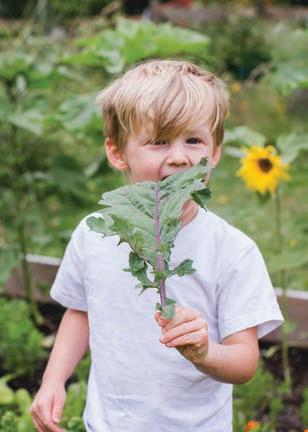
PICKY PLANTING
Over the years, I’ve picked up a lot of tips on vegetable growing, but the best way to start is to look for support from a local garden centre and a friend with a green thumb.
My top three starter plants for encouraging excited eaters without over-thetop effort are:
1. Lettuce greens
2. Sugar snap peas in the spring
3. Cherry tomatoes in the summer Veggies generally need an inch of water a week in mild temperatures, but in hot, windy conditions they can happily drink three times that.
Meredith is a former world champion freestyle skier turned television producer turned sport development expert specializing in inclusion for neurodiverse kids and, in 2018, turned farmer. Find Meredith Googling everything green at HappiLife Farm in the Pemberton Meadows.
VAIRDY FRAIL | PHOTOGRAPHER
Vairdy is a commercial and editorial photographer based in beautiful Squamish. She specializes in food and lifestyle photography and is committed to supporting brands and businesses that are making waves in their industry. Her friends describe her as adventurous, loyal and energetic, a requirement for keeping up with her husband and twin boys as they explore mountains and coastlines at home and abroad. e
Use larger pots because they retain moisture longer. I like pots 40 to 45 centimetres wide and deep. Before adding soil, put some old plastic containers upside down in the bottom of the pot to fill space and add drainage.
Generally, plants love six to eight hours of direct light a day, and, if possible, give them some protection from high winds and intense heat. But plants, like children, are remarkably resilient in a variety of conditions.
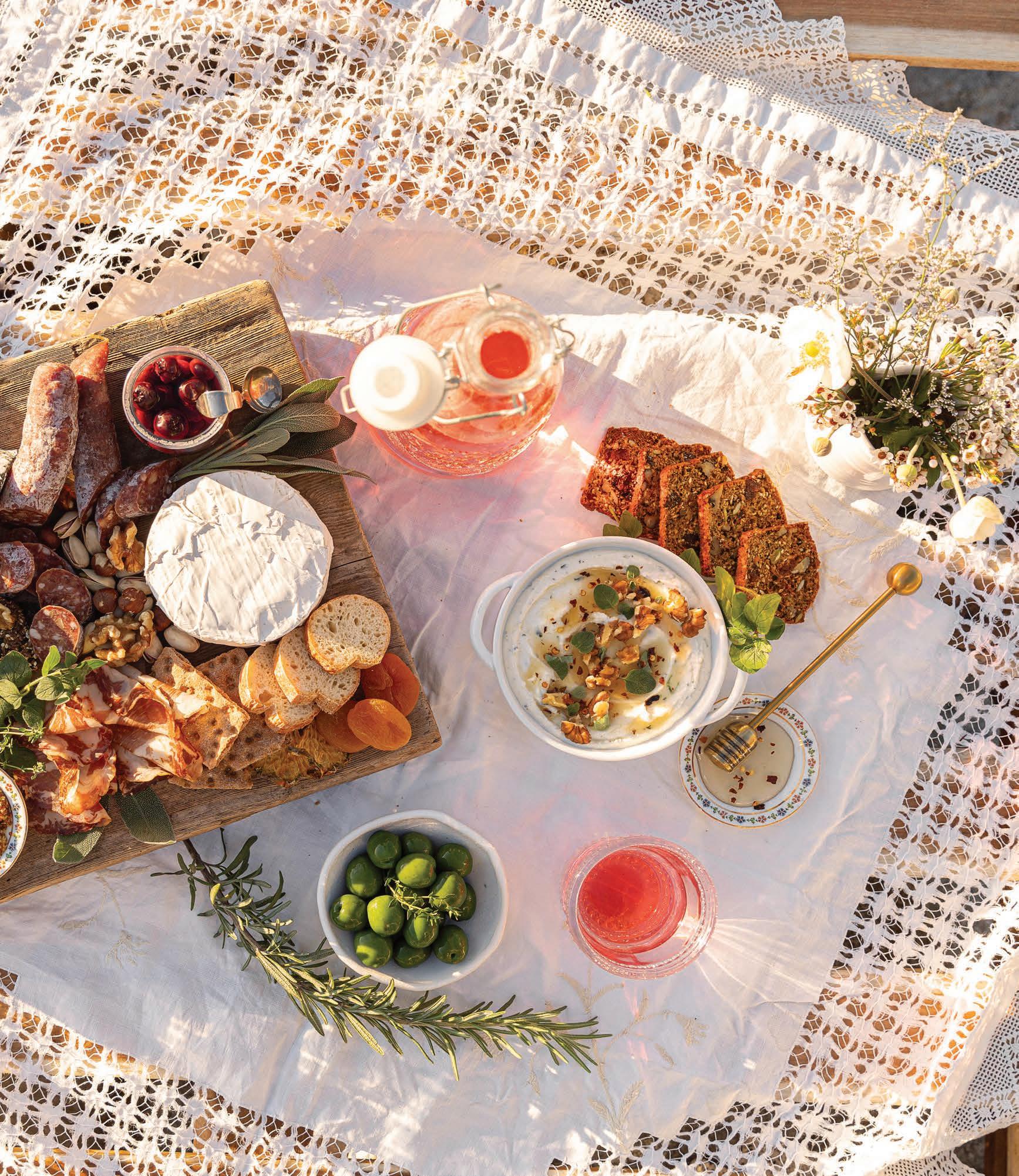
Rosemary Rye Crackers with Apricots and Walnuts
By Christine Montgomery
Photos by Vairdy Frail
RYE CRACKERS
MAKES APPROXIMATELY 64 CRACKERS
Pan-release spray for greasing pans (PAM or similar, or vegetable oil)
2 cups buttermilk
2 tablespoons honey
1 cup all-purpose flour
½ cup rye flour
½ cup oat bran
¼ cup brown sugar
2 tablespoons nutritional yeast
2 teaspoons baking soda
1 teaspoon table salt
1 cup walnuts
½ cup chopped dried apricots
¼ cup pumpkin seeds
¼ cup sesame seeds
2 tablespoons flax seeds (ground or whole)
1 tablespoon chopped fresh rosemary
Heat oven to 350°F and use pan spray to grease four 6-inch-by3-inch mini loaf pans.
In a small bowl, stir together buttermilk and honey; set aside. In a large bowl, whisk together flour, rye flour, oat bran, brown sugar, nutritional yeast, baking soda and salt. Mix in walnuts, apricots, all three types of seeds and rosemary. Pour buttermilk mixture into dry ingredients and stir until ingredients are evenly incorporated.
Pour an equal amount of batter into each of the four loaf pans and bake for 25 minutes, until the surface springs back when the middle is lightly touched. Remove pans from oven (but leave oven on) and let them rest for 5 minutes. Then unmould them onto a cooling rack. (At this point, loaves can be wrapped and frozen until ready to bake into crackers.)
Once loaves are completely cooled, use a serrated knife to cut each loaf into thin slices. Lay slices on baking sheets and place in oven. Bake for 22 to 30 minutes, flipping halfway through, until lightly coloured and crisp. Allow slices to cool completely, then eat or store in an airtight container.
CHRISTINE MONTGOMERY | FOOD STYLIST
Christine is a pastry chef, food stylist, artist and mom of two (and wife of one). After her culinary training and work throughout Vancouver, Christine started a bakery in West Vancouver with her mom, where they operated for eight years. Christine is now enjoying another side of food through food styling for print and film advertising in and around Vancouver. Working with local ingredients and exploring the beauty of food is a constant inspiration for Christine. Find out more or contact Christine at Fig Food Styling.

WHIPPED FETA SPREAD
MAKES APPROXIMATELY 2 CUPS
1 small garlic clove
1 cup feta cheese

½ cup cream cheese
½ cup Greek yogurt
Zest from ½ small lemon
Juice from ½ small lemon
¼ teaspoon black pepper
1 tablespoon chopped fresh oregano, plus more for garnish
1 tablespoon chopped fresh chives, plus more for garnish
Hot honey, for garnish (see following recipe)
Roasted and chopped walnuts, for garnish (roast at 350°F for 7 to 10 minutes)
In a food processor, pulse garlic, then add the two cheeses, yogurt, lemon zest, lemon juice and black pepper. Pulse until smooth and creamy, about 1 minute. Scoop the mix into a bowl and fold in oregano and chives. Add more pepper if desired. Top with a drizzle of hot honey, walnuts and a sprinkle of fresh herbs.
HOT HONEY
MAKES APPROXIMATELY ½ CUP
½ cup liquid honey
1 tablespoon apple cider vinegar
½ teaspoon chili flakes
In a small saucepan over medium-high heat, bring all ingredients to a boil. Stir, then remove from heat. Once cool, store in an airtight jar.
edibleseatosky.com | 13
The Art of Farming
At Laughing Crow Organics, the empty spring field is Kerry McCann’s blank canvas
By Lisa Richardson |
 by Brenda Bakker
by Brenda Bakker
Photos


Every year, the impossible goal to provision 600 households starts with the same blank canvas: bare earth, covered in snow, and a new crew of farmhands, keen, fresh-faced and committed to the beautiful vision of feeding people with organic food. Kerry McCann greets her annual quintet with a message. “I tell them to think of the farm as a painting. There’s a whole bunch of human effort that goes into it,” says McCann. “Care, concern and consideration. And it creates this thing of beauty.”
The recent arrivals are not afraid to get dirty or to work hard for a season, but after 10 years as the co-owner of Laughing Crow Organics, an organic mixed-vegetable farm located in the Pemberton Valley on the unceded territory of the Líl’wat Nation, McCann knows what lies ahead for them. She needs to give them something to get through heat waves, floods and fast-paced physical work. The thing that helped her: a way of looking at it all. “If you’d told me 10 years ago how hard it would be, I wouldn’t have done it,” says the now-39-year-old.
The idea of farming as art encourages her team to see themselves as co-creators, not just labourers. They will spend so many days ahead
trying to outrun a tidal wave of work. McCann reframes the landscape into an image, describing a painting that comes slowly to life, one brush stroke at a time.
A Blank Canvas
McCann’s medium is dirt. Her friend Brenda Bakker’s is makeup. As happens in small mountain communities, the pair occasionally trade services; Bakker takes care of McCann’s split ends and feeds her skin with moisture, and the farmer brings tomatoes and squash in return. They met when McCann first moved to Pemberton and worked in Bakker’s Christmas decorating business. While McCann laughs at the glamour disparity of their life paths, her theory of farming as creative expression hints at their connection.
Though Bakker has expressed her creativity for 20 years by mixing makeup palettes and styling models, brides and others, the idea of painting the farm into being, of hard work as an art practice, snagged the lifelong artist. It felt familiar, too. As a child she would sit in the sun-lit cab of her father’s truck, describing to him her inner world. He told her, “You see everything as if it’s a painting — an image frozen in a frame.”
16 | EDIBLE SEA TO SKY | SPRING 2024
The dedicated farmhands at Laughing Crow Organics pour themselves into their work, rain or shine, always with a smile.
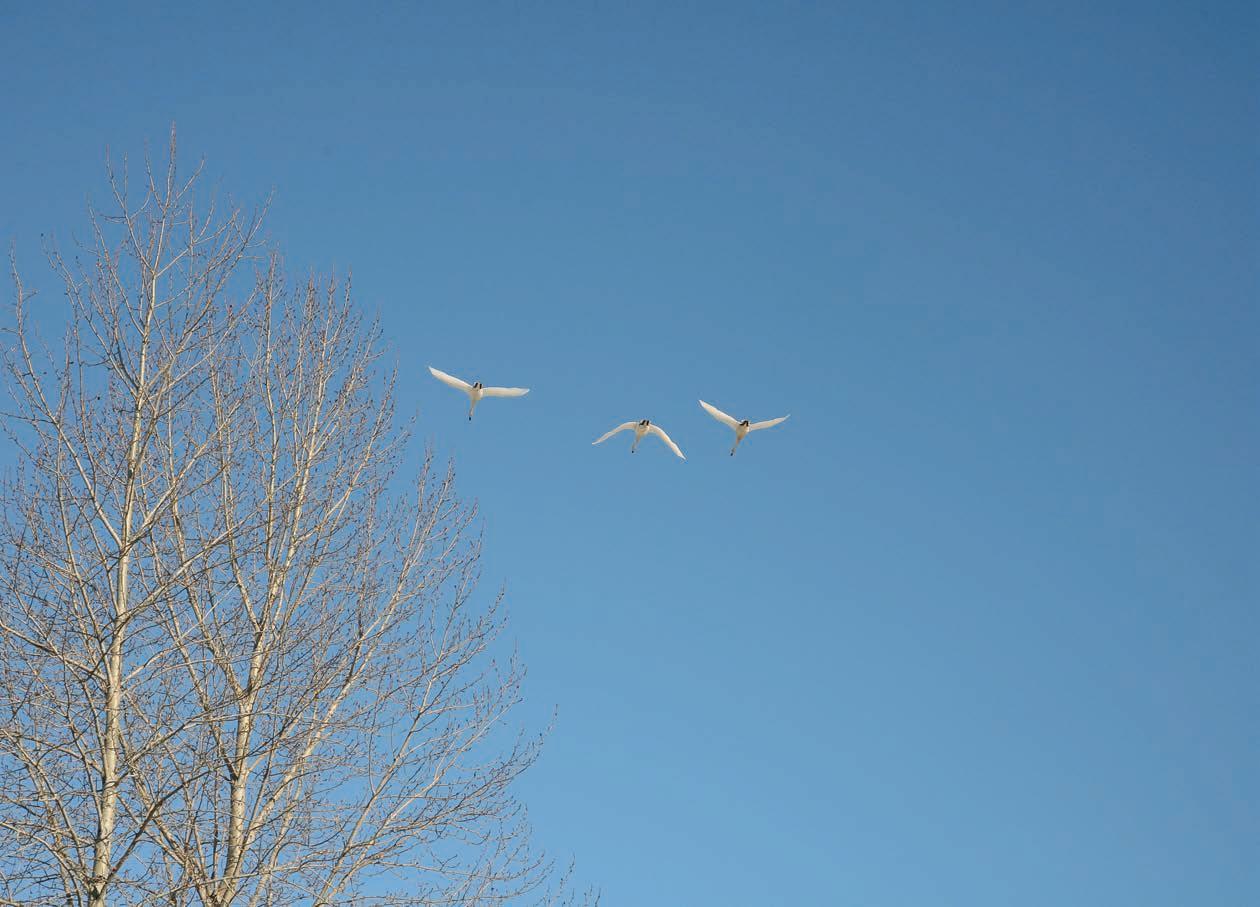
“It all begins with a spreadsheet, thousands of seeds and the same kind of hope-amnesia cocktail that serves all life-giving endeavours, from childbirth to farming.”
Bakker saw her friend’s farm in its blank-canvas state and wanted to capture its transformation into a finished masterpiece.
Each week, Bakker drove 12 kilometres up the Pemberton Meadows valley to The Beer Farmers, a craft brewery from which Laughing Crow leases their farmland. The rutted, winding road follows glacial-fed rivers through giant fields, and the peaks of the Coast Mountains fill the sky. She went in all weather, no matter what else was on her plate that week. Sometimes alone, sometimes with her seven-year-old twins in tow, always with no fixed agenda but to walk the fields with her camera, pay attention and notice what came to life.
Spreadsheets and Swans
On her first visit, the trumpeter swans arrived, harbingers of spring. Bakker says she looked out at the empty field and thought, “This is all going to be a gorgeous painting at some point, but right now, this is work. This is nothing but work ahead.”
Laughing Crow Organics grows about 45 different vegetables and 30 varieties of flowers on 10 acres. Another 4.5 acres supports its agritourism offerings, including a summer sunflower maze and the Grand Majestic Pumpkin Patch. The farm sells its produce at three weekend markets in Squamish and Whistler and delivers more than 30,000 pounds of vegetables through community supported agriculture (CSA) veggie boxes. Laughing Crow’s organic vegetables fill 210 boxes each week. Committing to the CSA service up front buys the season-long subscriber-investors 17 weeks’ worth of fresh produce delivered direct to their door.
Farming in a mountain climate like the Pemberton Valley sets certain constraints. The season is short. McCann and the five other small organic mixed-vegetable farms in the area get about 190 days to coax forth their crops before frost kills everything. Over just six months, they start the
edibleseatosky.com | 17
The arrival of the trumpeter swans is a sure sign that spring is on the way.

vegetables, transplant them, protect them from weeds and pests, harvest them, wash them, pack them and get them to the customers.
For McCann, it all begins with a spreadsheet, thousands of seeds and the same kind of hope-amnesia cocktail that serves all life-giving endeavours, from childbirth to farming. There is nothing but work ahead. But, like Bakker, McCann is driven to create.
Healing Hands
Running a small-acreage mixed-vegetable organic farm is incredibly hands-on. Witnessing all the tending on the farm enlivened Bakker. “The power of touch. It’s what you do with animals, babies, plants, to help them grow,” she observes. “But when you pick up a tomato at the market, you never think of that.”
After watering the baby tomatoes in the nursery, McCann brushes her hands gently over them, shooing the water off, helping strengthen their stems. She’s preparing them for the transition out of greenhouse, so they will be able to stand strong when the first wind comes along.
McCann practiced as a craniosacral therapist, massage therapist and yoga teacher before she became a farmer. Bakker found another kind of healing at the farm. “It is a real joy to hear her talk about soil, about her love of seeds and planting and growth and of feeding the community,”
“
If you’re having a moment of stress in your day, you go stand by some beautiful flowers and you can breathe. ”
Bakker says. The weekly visits to the farm became an earthy soul medicine. “It was my tether to get through stuff in my personal life. It became like art therapy for me.”
Despite the interruption to the workday, Bakker’s visits were supportive for McCann, too. Once the season begins, the to-do list never really ends. With a lean crew, everything is time blocked, every day listed out in a series of tasks, each with its own time budget. Despite how much McCann geeks out on the logistics, sometimes a job just takes longer than planned: weather, nature, broken water lines — all the variables conspiring to foil her schedule.
But Bakker’s visits brought a welcome disruption. “Just to have something slightly outside the list of the day’s objectives was a really great grounding tether for me,” McCann says. It helped her to see that it was not the end of the world if those flowers were not planted at the right spacing. “We’ll just replant them.” Though that meant pulling out every other plant and planting it again, she found it more palatable with another
18 | EDIBLE SEA TO SKY | SPRING 2024
Sunflowers, turning to face the sun, await cutting for bouquets.

objective person there. McCann says that Bakker’s presence reminded her, “These are just plants, they just want to grow. Nothing terrible has happened here. Nothing is really going wrong. We’re just going to do a bit of work over again.”
Sometimes, in her day-to-day life on the farm, those kinds of things can be stressful. With her friend observing, she found a chance to shift her perspective, step back and see the farm through an artist’s lens.
Breathing and Bouquets
Each Sunday, when she gets home from the Whistler Farmers’ Market, McCann walks around her fields. “Every week, something new will be coming to readiness — another crop of broccoli or a cauliflower or something that has been growing for 10 weeks and is finally ready to harvest.”
But for that tiny moment, she’s not checking off a to-do list, she says. “I’m creating it.” The walk gives her a chance to pause and ask herself what she sees, what she notices. “If there’s something particularly beautiful coming in, that will ground me and remind me that I am part of this beautiful creation, this effort to create something beautiful.” She often starts in the greenhouse, one of her favourite places on the farm. “It’s like a kind of church,” says McCann. Throughout
the farm, she finds the idyllic spots that feed her creativity. She seeks refuge in the flower patch, her time-out zone when everything is going full tilt, when the great growing experiment has hit its glorious peak and she’s chasing daylight to bring in armfuls of beets, cauliflower, cucumbers, carrots, radishes, kale and tomatoes. “If you’re having a moment of stress in your day, you go stand by some beautiful flowers and you can breathe.”
It doesn’t necessarily make business sense to add 30 more crops with a long growing season to the mix. She does it for joy. “I never would buy myself flowers,” she says, describing herself as the terrible girlfriend who would receive flowers with a litany of questions: “Where did these come from? Are they ethical? How much were the people paid? Why wouldn’t you buy me a plant?”
And yet, now that she grows flowers, she loves having a bouquet in the house, especially in her bathroom. “You’re in there a couple of times a day, so you can really appreciate them.”
Finding crew time to plant flowers is a victory against the clock, the to-do-list, the tidal wave of fecundity they’re in service of. Even if someone misspaces them and planting has to be done over again. It wasn’t until she saw Bakker’s photos that she could perceive just how well her vision had been realized: tiny uprooted seedlings and giant blocks of colour in bloom.
edibleseatosky.com | 19
A farmhand washes freshly harvested greens.
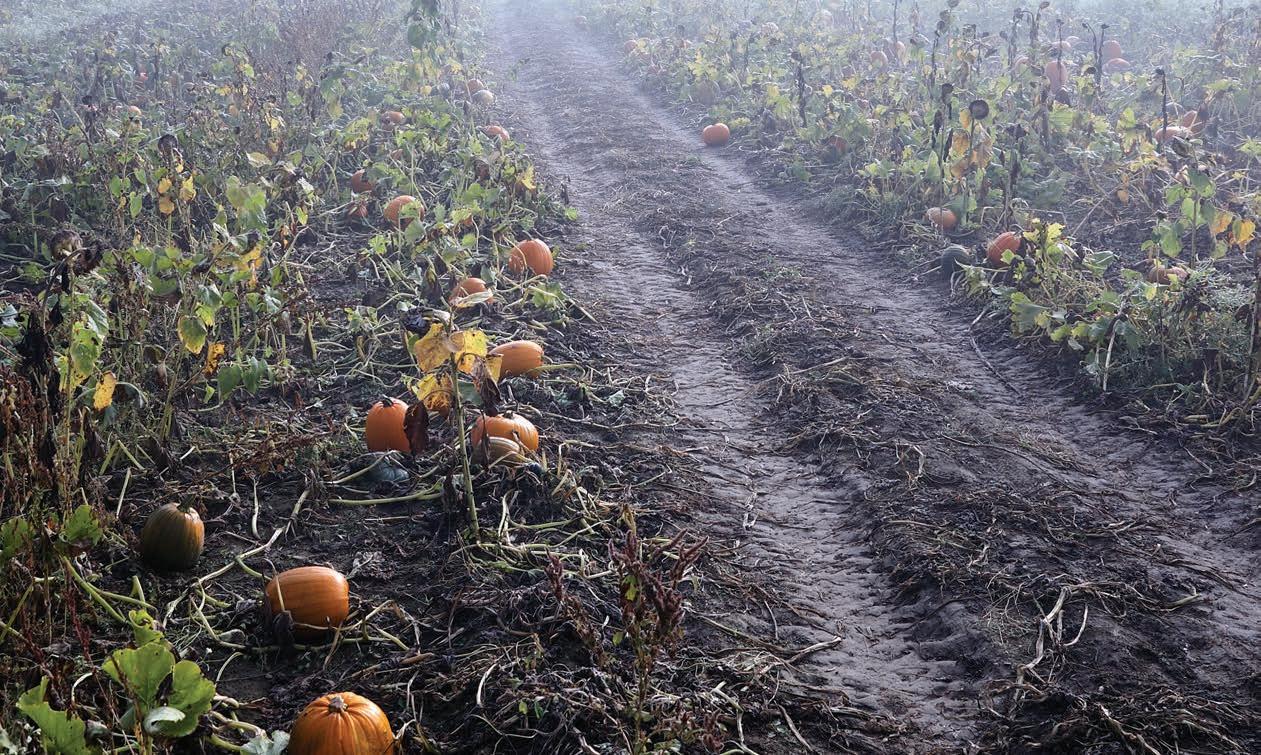
“It tips so fast from ripe to rotting. You have to really be there to catch the moment.”
A Cycle of Hope
In the late fall, fog comes down over the valley. The frost has killed off anything green; only lumpy orange orbs of squash remain. McCann has a storage room full of squash to deliver and a season of rest and integration to transition into. Time to paint, make art with dried flowers and prepare soups she can sit down and eat, rather than slurp and run.
“It tips so fast from ripe to rotting. You have to really be there to catch the moment,” says McCann. She is grateful that Bakker was there to freeze time. After the slow growth from blank canvas to brilliant image, the speed of decline always surprises her, a reminder of how fundamentally plants demonstrate the finiteness of life. “The zeal of youth, the beauty of ripening and fullness, the beauty of their aging and being slightly past prime, on to decay,” McCann describes.
“But there’s beauty in decay, too,” adds Bakker. Her project documented all the ages and stages of a growing season on a small mixed-vegetable organic farm — one full cycle of life and death — but those first photos look different in hindsight. No longer empty. “I saw something composted, rotted, but with new life on it, coming out of that cold, cold earth,” she says.
“Perennially, in March, I am filled with hope,” says McCann. Things don’t always go the way she wants, or the way she plans, but it all begins with seeds of optimism. “Every year, we have this renewed hope. That the season will be kind to us. Things will grow again.”
LISA RICHARDSON | WRITER
When Lisa first moved to Pemberton from the Australian suburbs, she thought radishes grow in bunches, because that’s how they come in the store. Meeting local farmers was one way that living on the unceded land of the Líl’wat Nation has helped re-educate her, making her a passionate advocate for local food, seasonal rhythms and reconciliation. She is a co-founder of Pemberton’s agritourism event the Slow Food Cycle Sunday and a prolific freelance writer. Her writing has been translated into multiple languages, has appeared in a wide range of lifestyle publications and has earned her the title of “Pemberton’s Favourite Writer” since 2007. Find more at lisarichardsonbylines.com.
BRENDA BAKKER | PHOTOGRAPHER
Brenda’s work as a hair, nail and makeup artist has been featured in Harper's Bazaar, Glamour, Flare, Fashion, Pulp, Strut, WedLuxe, Weddingbells and Real Wedding Magazine. Partner, gardener, yoga student and teacher, cold plunger and mother of twin boys, Brenda lives and learns on the ancestral and unceded territories of the Líl’wat Nation and St'át'imc Nation. Whether she is working alongside film and television celebrities, catwalk models, brides or organic farmers, Brenda’s goal is the same: to deepen connection and help people feel beautiful from the inside out. This is her first photography feature for a magazine.
20 | EDIBLE SEA TO SKY | SPRING 2024 e
Pumpkin fields wait patiently for the harvest under a blanket of fog.






edibleseatosky.com | 21

BORROWING BIODIVERSITY
The Lillooet Seed Lending Library gives gardeners a helping hand
By Sue Senger | Illustration by Ellena Deen
Twenty-five years ago, seed packets cost a dollar or two and held several years’ worth of seeds. Today, five dollars often buys only 10 tomato seeds. This is no accident: Just four corporations control half the world’s seed supplies.
But things look different at a local level, where dedicated gardeners and growers are stepping in to enact change. The Lillooet Seed Lending Library allows gardeners to borrow seeds for the season and return them in the fall. It also provides resources to people starting a food garden and supports the preservation of disappearing plant varieties.
“Year after year, the seeds multiply through the gardens of the seed borrowers.”
The library stemmed from Roots Gatherings in the St’át’imc community of T’ít’q’et, created around 2008 by Doreen Whitney and Susannah Tedesco of the Úcwalmicw Centre. The workshops focused on developing self-sufficiency
skills such as canning, herbal medicine, butchering and fermentation, always ending with a feast of local foods.
Inspired by these events, eight community members later formed an ad hoc group called Lillooet Food Matters. Their core mandate is to build local food security, ensuring everyone has access to enough high-quality, affordable and nutritious food. They work towards food sovereignty for all, which takes the concept of food security one step further to include healthful, culturally appropriate foods grown in sustainable and ecologically sound ways.
While the faces have changed over the last 15 years, the primary focus on food security remains the same, and seed saving is the cornerstone of creating that security. Without seeds, there is nothing to grow.
The portable Lillooet Seed Lending Library was created in 2013 and now travels to community and seed-saving events, pops up at the Lillooet Farmers Market and visits Lillooet storefronts such as Seed to Culture and The HUB.
What Is the Seed Library?
The portable seed library is a beautiful wooden display rack that holds packages of seeds, sorted by type. Some seeds are in commercial envelopes with detailed descriptions; others are in brown paper envelopes with handwritten names.
Much like the public library, everyone is welcome to use the seed lending library. Users sign out, or “borrow,” seeds from the library and plant them. They get to eat the food they
edibleseatosky.com | 23
grow from the seeds, but must leave some of the plants to reach the seed-setting stage. Then, at the end of the growing season, users collect the seeds and return them to the library, fulfilling their obligation and ensuring there are seeds available the next year for someone else to try. Year after year, the seeds multiply through the gardens of the seed borrowers.
“Our goal is to encourage and support gardeners and farmers to grow our seeds for themselves and return some to the library for others to take out,” says Eleanor Wright, one of the original community members who helped set up the library. New seed savers need not worry — the library also provides instructions and support for growing selected crops and saving the seeds, including printouts about how to save seeds, sorted into easy, intermediate and advanced levels.
“Food security in the future depends on maintaining access to seeds now.”
If gardeners already have some heirloom or rare seeds, the library wants to help preserve them. “We welcome seed donations to the library, and especially encourage the entrusting of heritage seeds to our collection,” says Wright. Lillooet Food Matters members include plenty of people with the experience and desire to maintain the viability of any valuable seeds — and they always welcome new volunteers.
Why Save Seeds?
Back in the early 1900s, everyone who grew a garden saved seeds. It was the only way to ensure food for the following year.
When seed companies became involved, they focused on high productivity and making money, rather than on creating nutritious staple foods. The diversity of culinary seeds began to decline, and the price of buying seeds increased dramatically.
By 1983, 96 percent of corn varieties, 94 percent of peas and 81 percent of tomatoes were gone. Unless someone grows the seeds and saves them each year, varieties simply disappear. If no source for the seeds remains, gone from the marketplace becomes gone forever.
Preserving plant diversity is an essential asset for finding varieties capable of growing in the shifting conditions created by climate change, so food security in the future depends on maintaining access to seeds now. That’s a big responsibility for small organizations such as the Lillooet Seed Lending Library. But it opens up opportunities for anyone to get involved, save seeds — and money — and be a part of a community effort to ensure food security and, eventually, food sovereignty for Lillooet.
Get involved: Watch for sharing events like Seedy Sunday, volunteer with the Lillooet Seed Lending Library or visit the library’s website for more information: lillooetfoodmatters. com/our-projects.
SUE SENGER | WRITER
Sue is a landscape ecologist by trade (PhD, Biology; MSc, Plant Science), with a passion for homegrown food and smallscale farming. She’s spent her career translating science into understandable components and actionable steps that support good decision-making on the land. Join her newsletter, The Naturalized Human, on Substack (suesenger. substack.com) for a focus on the mind-body-food connection, or visit Rose Hill Farm online (rosehillfarm.ca) for more hands-on farming features.
ELLENA DEEN | ILLUSTRATOR
Ellena is originally from Sydney, Australia, and currently lives in beautiful Squamish. She has lived between Canada and Australia for chunks of her life and has always loved both for different reasons. Squamish has always felt more like home, with the towering mountains and deep forests. It’s one of her favourite places to be. Her painting is something her time in both places has in common, highlighting her ability to make the best of both worlds shine. During COVID, when she was finishing school, her interest in painting grew. Now it is one of the main things in her life.
24 | EDIBLE SEA TO SKY | SPRING 2024 e

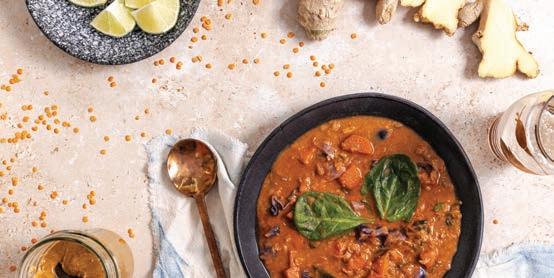




edibleseatosky.com | 25 Capturing Flavor, Crafting Stories Bespoke Visuals for Local Food Businesses and Brands vairdy.com hello@vairdy.com @vairdy_photography
What Is a CSA?
Everything you need to know to support your local farm all season long
By Kerry McCann, Laughing Crow Organics
Learn about turnips, garlic scapes and the loveliest of lettuces this spring. Eating your vegetables gets easier, tastier and more enticing when a locally grown selection just shows up each week. Even better, your subscription to local produce — and more — through a community supported agriculture (CSA) program enables farms to grow and harvest more effectively through the entire growing season.
A CSA program is a mutual commitment between food growers and their community — eaters, customers, you. Members purchase a share of the harvest before the growing season begins, providing farmers with much-needed and muchappreciated capital in the leanest and most expensive period of the year. Shareholders secure an allocation of the farm’s harvest, usually in weekly boxes of fresh, seasonal veggies, plus the good feelings and bragging rights that come with supporting sustainable food systems of the great nearby.
How the CSA works varies from farm to farm, but most Sea to Sky CSAs run for 15 to 20 weeks. When it comes to the timing of the growing season in these parts, nature is the ultimate decider, but it generally runs from mid-June to late October. Some CSAs offer pickup on the farm or at one or more convenient central locations, while others offer delivery. In the more traditional models, farms pack the boxes with the “farmer’s choice,” curating the contents themselves and surprising members, but some farms allow members to build their own box each week by logging in to an account and choosing from available items. With either model, many farms offer extras for purchase, weekly or as available, including eggs, dairy products, flowers and canned or preserved products.
CSAs allow anyone to create a relationship with the people who grow their food, and they form the backbone of the business for many local growers. The returning and steadfast support of CSA memberships allows farms to grow with security over the years.
e
KERRY MCCANN
Kerry co-owns and operates Laughing Crow Organics farm. For the past 10 years, she has been dedicated to growing the farm business. Kerry is passionate about farming, small farms, systems and efficiency for farmers, land stewardship, really good food, flowers and birding.


26 | EDIBLE SEA TO SKY | SPRING 2024
Advertise with
support
us to
the stories edible sea to sky

Get to Know Your Local Grower
BLACKWATER CREEK ORCHARD
DEVINE, BC
SEASON: 17 weeks, from June to the end of October
INCLUDES: A wide range of vegetables and at least one fruit option
DELIVERY: D’Arcy to Mt. Currie
PICKUP: Pemberton
OPTIONS:
- Personalize your box online
- 5-week spring share
- Vacation holds blackwatercreekorchard.com/csa
FOUR BEAT FARM
PEMBERTON, BC
SEASON: 20 weeks, from June to December
INCLUDES: Weekly organic produce in small and large sizes
DELIVERY: Squamish, Whistler, Pemberton
OPTIONS:
- Customizable weekly vegetable selection
- Option to add eggs, fruit or flowers
- Weekly farm newsletter with recipes and tips
- Summer and winter shares
- Vacation flexibility fourbeatfarm.ca
ICE CAP ORGANICS
PEMBERTON, BC
SEASON: 20 weeks, from June to October
INCLUDES: 8 to 10 varieties of produce for a family of 2 to 4
DELIVERY: Pemberton, Whistler
OPTIONS:
- Newsletter with recipes
- Pickling cucumber packs, canning tomatoes and bulk garlic icecaporganics.com/harvest-boxes-csa
LAUGHING CROW ORGANICS
PEMBERTON, BC
SEASON: 17 weeks, from June to October
INCLUDES: 6 to 12 “farmer’s choice” seasonal vegetables per box
DELIVERY: Pemberton, Whistler, Squamish
OPTIONS:
- Flower CSA
- Canned, pickled or fermented items
- Add bulk orders of tomatoes, onions, garlic, potatoes and squash to delivery
- Meal suggestions and recipes laughingcroworganics.com/csa
NUTRIENT DENSE FARM
UPPER SQUAMISH VALLEY, BC
SEASON: Up to 26 weeks, from June to November
INCLUDES: 6 to13 seasonal organic vegetables per box
DELIVERY: Squamish
PICKUP: Brackendale, Squamish, Vancouver
OPTIONS:
- Choose summer and/or fall
- Shares for 1 to 5 people
- Recipes
- Egg share
- Add bulk orders of pickling cucumbers, tomatoes and cabbage nutrientdensefarms.net/about-3
PLENTY WILD FARMS PEMBERTON, BC
SEASON: Up to 34 weeks (sign up by April 24 for May to December)
INCLUDES: More than 50 types of certified organic produce
PICKUP: Pemberton, Squamish, Whistler
OPTIONS:
- Share amount is added to a card used to shop in the online store
- Monthly newsletter
- Farm tour
- Dried beans, cornmeal, eggs, fruit, flowers and mushrooms
- Unused share amount rolls over to the next year plentywild.ca/what-is-a-farm-share.html
ROOTDOWN ORGANIC FARM PEMBERTON, BC
SEASON: 15 weeks, from June to October
INCLUDES: Mixed vegetables
PICKUP: Whistler, Pemberton
OPTIONS:
- Fully customizable box
- Early and late season add-ons
- Egg shares
- Early-bird bonus
- Refer-a-friend bonus
- Vacation holds rootdownfarm.net/harvest-box
edibleseatosky.com | 27
find
right
Consult this list of local CSA programs to
the one that is
for you
Photo: Vairdy Frail

Gravlax Salmon Pesto Salad
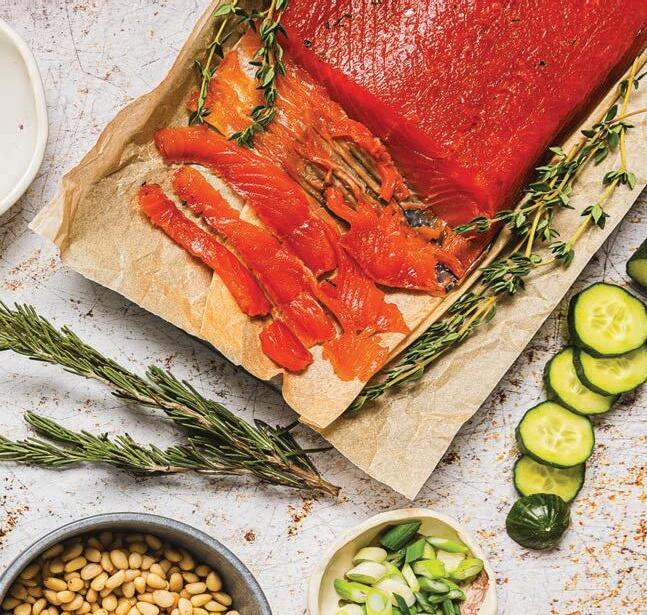 Photos by Vairdy Frail
Photos by Vairdy Frail
GRAVLAX
1½ teaspoons finely chopped dill
1½ teaspoons finely chopped rosemary
1½ teaspoons finely chopped thyme
½ cup granulated sugar
¼ cup pickling salt
1 teaspoon paprika
1-pound fillet sockeye salmon
In a bowl, mix the fresh herbs with sugar, pickling salt and paprika.
Place fillet on plastic wrap, skin side down. Add herb and spice mix on top of fillet, then wrap tightly with the plastic wrap. Put on a plate in the fridge for 24 hours to cure.
Remove from fridge. Drain liquid that has gathered in the plastic wrap, scrape off herb and spice mix, rinse fish lightly and pat it dry. Place fillet in the freezer for 15 minutes prior to slicing; this will make it easier to cut. To slice, place fillet skin side down on a cutting board. Use a sharp knife with the blade at about a 30-degree angle from the fillet, almost horizontal against the fish. Make thin slices against the grain, applying pressure when pushing the knife down.
SERVES 2
SALAD
2½ tablespoons vegetable oil (or other high-heat oil)
2 teaspoons capers
4 cups mixed greens
2 tablespoons pesto dressing (see below)
8 thin slices gravlax (see below, or substitute store-bought lox)
8 cherry tomatoes, halved
6 slices watermelon radish, quartered
6 coins cucumber, halved ½ avocado, sliced ¼ green onion, sliced
In a medium saucepan over medium-high heat, heat oil and fry capers until crispy, 2 minutes. Use a slotted spoon to transfer capers onto a paper towel. Toss mixed greens in pesto dressing. Add gravlax, tomatoes, radish, cucumber, avocado and green onion on top.
PESTO DRESSING
¼ cup pine nuts
2 cups loosely packed basil
Juice of ½ lemon
1 garlic clove, crushed
1½ tablespoons vegetable oil
1½ tablespoons extra virgin olive oil
Salt and pepper, to taste
Preheat oven to 325°F. Spread pine nuts in a single layer on a baking sheet and bake for 15 minutes, stirring every 5 minutes, until golden brown.
In a blender or food processor, blitz toasted pine nuts, basil, lemon juice and garlic. Slowly add both the oils while continuing to blend for 30 seconds, scraping the sides as needed. Taste dressing and season with salt and pepper as desired.
edibleseatosky.com | 29
Recipe courtesy of Hunter Gather Eatery & Taphouse, Whistler, BC
Stalking Springs Sweetness
Rhubarb brings local notes to a classic cocktail
By Michael Kompass | Photos by Vairdy Frail

When the crocus rears its colourful head and we trade skis for bikes, the season of renewal is here. The Sea to Sky 75, a twist on the French 75, celebrates the new season with something fresh from the majestic bounty of the Pacific Northwest. Say au revoir to lemons and Champagne, and build this seasonal, local version of the classic cocktail instead.
The first shoots of rhubarb step in as a substitute for the tangy quality of the lemon. Used in moderation, rhubarb’s intensity adds just a subtle hint here, along with a splash of colour. The rhubarb strawberry cordial from Squamishbased Frost Bites Syrup Co. uses Pemberton Valley rhubarb and takes the place of simple syrup, adding a tantalizing sweet-tart boost.
’

Sea to Sky 75
Montis Distilling makes two gins, offering a pair of options for the drink. The Alpine Gin, made with botanicals foraged from around Whistler, imparts forest-like character with emphasis on juniper and conifer notes, while the Alpenglow Gin’s citrus focus brings floral, botanical vibes.
Topped off with B.C. sparkling, the Sea to Sky 75 hints at the new opportunities, fresh starts and sunny days soon on their way.
1 ounce Montis Gin (either Alpine or Alpenglow)
¾ ounce Frost Bites Syrup Co. Rhubarb Strawberry Cordial 5 centimetres rhubarb, chopped into 6 to 8 small pieces, plus a long, thin ribbon for garnish
3 ounces Blue Mountain Brut Rosé
In a cocktail shaker, combine gin, cordial and chopped rhubarb with ice. Shake until well chilled and then strain contents into a tall flute. Fill the glass the rest of the way with sparkling wine and garnish with ribbon of rhubarb.
MICHAEL KOMPASS | WRITER
Michael has been a resident of Sea to Sky Country since 1997. As a graduate of both the International Sommelier Guild and the Wine & Spirit Education Trust, he is the co-owner/operator of the Blackcomb Liquor Store and Fitzsimmons Pub in Whistler, as well as the creator and director of the Whistler and Squamish Wine Club since 2001. In addition to all things beverage related, Michael enjoys skiing, snowboarding, camping, rugby and good barbecue!

SPRING WHAT’S IN SEASON?
FRESH
Arugula
Asparagus
Bok choy
Endive
Kale
Onions
Radishes
Rhubarb
Salad greens
Spinach
Swiss chard
HOTHOUSE
Cucumbers
Garlic
Peppers
Tomatoes
FRESH HERBS
Bay leaf
Chervil
Chives
Cilantro
Dill
Oregano
Parsley
Rosemary
Sage
Sorrel
Tarragon
Thyme
Winter savory
Photo: Vairdy Frail
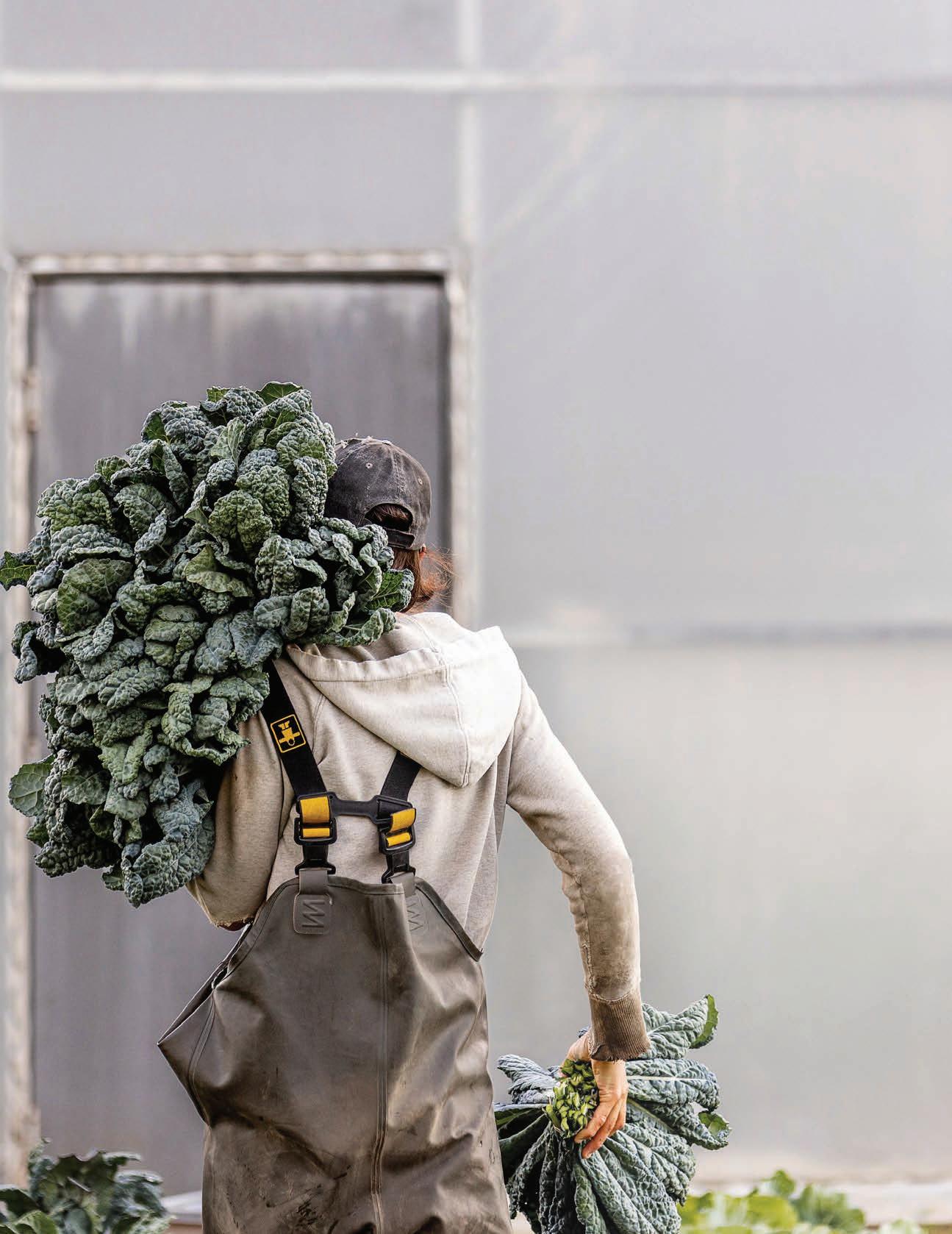

Miss an
Subscribe today and have edible SEA TO SKY delivered to your door each season www.edibleseatosky.com edible sea to sky
Never
Issue

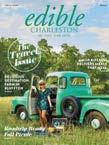









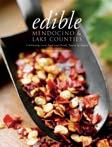














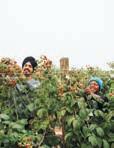




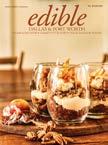

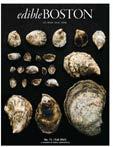




















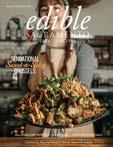
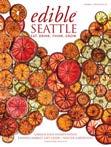
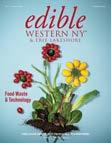






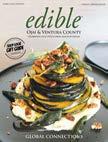



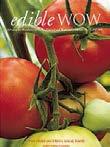
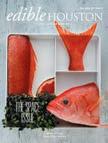






is a network of magazines across the U.S. and Canada edible BOZEMAN Telling the Stories of Local Food Drink Member Edible Communities WOLDY REYES Celebrating the Abundance Local Foods, Season by Season edible Cape Cod edible east end Celebrating Harvest the Hamptons and North Fork No. High Summer 2012 ISSUE ROMILLY NEWMAN PARTY THE The future of food MILK & HONEY Celebrating 10 years Holiday Feasts edible PHILLY elebrating Local Food Stories Vancouver Island The Gulf Islands edible VANCOUVER & WINE COUNTRY FROZEN BERRIES BETTER BUTTER VEGAN BREAD GET WET the land ~ the sea the people ~ the food edible M aritimes Wild Finds edible newfoundland & labrador the land ~ the sea ~ the people ~ the food Asparagus Marilyn Schlossbach Montclair Grape Debate CSAs Restaurant Guide Spring Destinations edibleJersey Number 79 Celebrating Local Foods of the Garden State, Season by Season Spring 2023 We are part of something bigger! Scan to learn more



























 Drody
Drody









 by Brenda Bakker
by Brenda Bakker























 Photos by Vairdy Frail
Photos by Vairdy Frail














































































